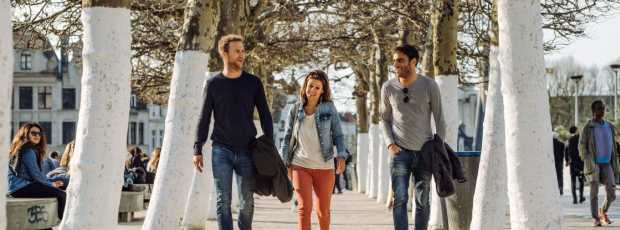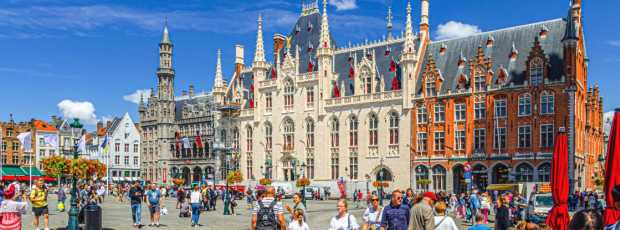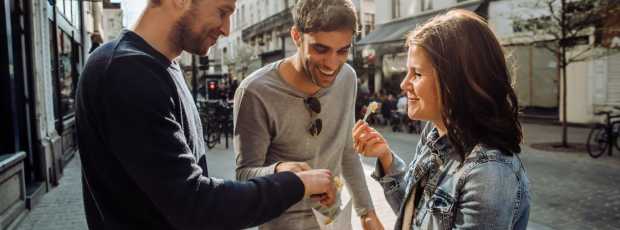Table Of Contents
- What to Know Before Traveling to Brussels
- Do and Don'ts in Belgium
- What Is the Best Way to Get Around in Brussels?
- How Many Days in Brussels Is Enough?
- Essential Brussels Tourist Attractions
- Where to Experience Belgian Food Culture
- Navigating Brussels Like a Local
- Art Nouveau: Brussels' Architectural Signature
- Museums Worth Your Time
- Getting to and from Brussels Airport
- Brussels Travel Beyond the Center
- Brussels Card: Worth It or Skip It?
- Weather and What to Pack
- EU Parliament and European Union Sites
- Insider Tips for Smart Travelers
- Day Trip Options from Brussels
- More Tips for Brussels Travel
- Hidden Gems Beyond the Guidebooks
- Making Brussels Worth Your Time
Look, I get it. Brussels doesn't exactly scream "dream destination" like Paris or Rome. But here's the thing about the capital of Belgium, it's precisely this understated quality that makes it worth your time. After spending considerable time in this beautiful city, I've learned that the best Brussels travel tips aren't about hitting every tourist attraction on your checklist. They're about understanding how this small country's administrative center actually works.
What to Know Before Traveling to Brussels
Before you visit Brussels, understand that this isn't just another European capital. This city serves as the administrative center of the European Union, which means it operates differently than other cities you might have explored. The Brussels capital region functions as both a political hub and a surprisingly livable urban space.
The official languages here are French and Dutch, though you'll hear plenty of English in tourist areas. Don't stress about the language barrier, most locals switch to English without missing a beat. What you should know is that Brussels Belgium operates on a different rhythm than other cities. Government buildings close early, many restaurants have specific hours, and the city center empties out after work hours.
Public transportation runs efficiently, connecting Brussels Central Station to Brussels North and Brussels South. The metro, trams, and buses form an integrated network that makes getting around straightforward. A day pass costs around €8 and covers all public transport zones you'll likely need.
Do and Don'ts in Belgium
Do This in Brussels
Embrace the plat du jour culture. Many restaurants offer daily specials that represent better value and fresher ingredients than their regular menu. Order moules frites at least once, it's not just tourist food, it's genuinely what locals eat. Visit chocolate shops, but skip the ones with English signage plastered everywhere. The best chocolatiers like Pierre Marcolini don't need to advertise to tourists.
Try Belgian beer, but don't go crazy with the variety. Pick one or two styles you enjoy and stick with them. The Delirium Café might be famous, but it's also expensive and crowded. Find a local café instead.
Don'ts That Matter
Don't avoid visiting during shoulder seasons. Spring and fall offer the best balance of decent weather and fewer crowds. Pack a rain jacket regardless of when you travel - this is Belgium, after all. Room rates drop significantly outside summer months, making it an ideal time for budget-conscious travelers.
Don't assume everyone speaks English immediately. Try "Bonjour" or "Goedendag" first – it shows respect and usually gets you better service. Don't tip excessively; 10% is standard and often already included in the bill.
Looking for a private city experience in Brussels?
Explore the city with a local who plans a private day just for you; no groups, no scripts.
What Is the Best Way to Get Around in Brussels?
Public transportation in Brussels works better than most visitors expect. The STIB network connects all major tourist attractions and neighborhoods efficiently. A single journey costs €2.40, but day passes make more sense for visitors.
Walking works well in central Brussels. The city center is compact, and most major sites sit within a 20-minute walk of each other. Google Maps works reliably here, though sometimes underestimates walking times due to Brussels' hilly terrain.
For day trips to other cities like Antwerp or Ghent, trains from Brussels Central Station run frequently. The national rail network connects Belgium's major cities efficiently, making Brussels an excellent base for exploring the country.
Avoid taxis unless absolutely necessary. They're expensive and often slower than public transport during busy periods. Uber operates here but costs significantly more than trains or metro.
How Many Days in Brussels Is Enough?
Three days covers Brussels' essential experiences without feeling rushed. Day one: explore the Grand Place, wander through Galeries Royales Saint Hubert, and get oriented in the city centre. Day two: dive into museums and art nouveau architecture. Day three: venture beyond tourist areas into neighborhoods like Saint Gilles.
Two days works if you're focused and don't mind a packed schedule. One day barely scratches the surface – you'll see the Grand Place and maybe one museum, but you'll miss what makes Brussels worth visiting.
Four or five days allows for a more relaxed pace and day trips to other Belgian cities. This timeline lets you discover hidden gems and experience Brussels like locals do, rather than rushing between tourist attractions.
Essential Brussels Tourist Attractions
Grand Place: More Than Just a Photo Op
The Grand Place deserves its UNESCO status, but visit early morning or late afternoon to avoid crowds. The Gothic town hall and guild houses create one of Europe's most impressive medieval squares. First Sunday of each month offers free entry to many surrounding museums.
Art Nouveau Architecture Beyond the Guidebooks
Victor Horta's influence shaped Brussels' architectural identity. The Horta Museum showcases the art nouveau style at its finest, but don't stop there. Walk through Saint Gilles to see art nouveau buildings still used as private residences. The art nouveau architecture here isn't museum pieces – it's living urban development.
Museums That Actually Matter
The Royal Museums of Fine Arts house impressive collections, but their temporary exhibitions often prove more interesting than permanent displays. Check what's showing before you visit. The car museum appeals to specific interests, while the comic strip museum celebrates Belgium's contribution to graphic arts.
Many museums offer free entry on specific days. The Brussels Card provides access to multiple museums but only makes financial sense if you're planning to visit several in a short time.
What if your day in Brussels was planned by someone who knows it — and you?
City Unscripted matches you with a local host who creates a private experience based on your interests, not a set route.
Where to Experience Belgian Food Culture
Beyond Waffles and Chocolate
Belgian beer culture extends far beyond tourist bars. Find a local café where regulars gather after work. Try different styles – Belgian brewing traditions vary significantly by region. Don't feel pressured to try everything; quality over quantity applies here.
Moules frites appears on every menu, but preparation varies dramatically. The best versions use fresh mussels, properly seasoned broth, and twice-fried potatoes. Many restaurants in tourist areas serve frozen mussels – locals know the difference.
Delicious Food in Unexpected Places
The best delicious food often comes from unassuming places. Look for restaurants filled with locals during lunch hours. The plat du jour at neighborhood bistros usually offers better value and flavor than tourist-focused establishments.
Chocolate shops range from industrial tourist traps to genuine artisanal operations. Pierre Marcolini represents the premium end, but smaller chocolatiers often provide better value and more interesting flavors.
Navigating Brussels Like a Local
Public Transport Strategies
Public transport in Brussels connects neighborhoods efficiently once you understand the system. Trams serve tourist areas well, while metro lines connect outer districts to central Brussels. Night buses run limited routes, so plan accordingly.
Buy transport tickets before boarding. Validators exist on all vehicles, and inspectors check regularly. Tourist passes include public transportation, but daily passes often provide better value for short visits.
Timing Your Visit
Avoid visiting Brussels during EU Parliament sessions if you want to avoid crowds. The European Parliament brings thousands of delegates, journalists, and support staff to the city. Hotel prices spike and many restaurants get booked solid.
Cultural events happen year-round, but summer brings outdoor festivals and longer daylight hours. Winter offers fewer crowds and cozy indoor activities, plus reasonable room rates.
Art Nouveau: Brussels' Architectural Signature
Art nouveau defines Brussels' architectural character more than any other style. Victor Horta pioneered the movement here, creating buildings that broke from traditional design patterns. The art nouveau style emphasized natural forms, flowing lines, and innovative use of materials.
Mont des Arts provides excellent views of the city's architectural mix. From here, you can see how art nouveau buildings integrate with medieval structures and modern European Union buildings. The contrast illustrates Brussels' evolution from medieval trading center to modern administrative center.
Self-guided tours of art nouveau buildings work well with a good map. Many significant buildings serve as private residences, so respect privacy while admiring exterior details. The Horta Museum offers the best interior examples of the style.
Tip
We match you with the right host, not just any guide.Want to experience the real Brussels with someone who lives there?
A fully private experience, planned and led by a local host who tailors the day to you
Museums Worth Your Time
Brussels' museums cater to diverse interests, from fine arts to comic strips. The Royal Museums house impressive collections spanning centuries of European art. Their temporary exhibitions often showcase contemporary works alongside historical pieces.
Interesting museums extend beyond traditional art collections. The comic strip museum celebrates Belgium's contribution to graphic arts, while specialized museums cover everything from musical instruments to brewing history.
Free entry opportunities exist throughout the year. Many museums offer reduced admission on specific days, and some provide completely free access on the first Sunday of each month. Check individual museum websites for current policies.
Getting to and from Brussels Airport
Brussels Airport sits about 12 kilometers from the city center. The Airport Express train connects the airport to Brussels Central Station in 20 minutes. Trains run every 15 minutes during peak hours, making this the most reliable transport option.
Buses provide cheaper alternatives but take longer and depend on traffic conditions. Taxis cost significantly more and don't offer time advantages over trains. Uber operates from the airport but surge pricing often applies.
If you're staying in Brussels North or Brussels South, check which transport option serves your area best. Some areas connect more easily via bus, while others favor train connections.
Brussels Travel Beyond the Center
Saint Gilles offers authentic Brussels experiences away from tourist crowds. This neighborhood features art nouveau architecture, local restaurants, and parks where residents actually spend time. The area feels like a real community rather than a tourist destination.
Explore neighborhoods beyond the city centre to understand how Brussels actually functions. Many restaurants, cafés, and shops in these areas cater to locals rather than visitors. Prices drop, quality often improves, and you'll experience Brussels as residents do.
Day trips from Brussels open up other Belgian cities. Antwerp, Ghent, and Bruges each offer distinct experiences, and trains connect them efficiently. Consider Brussels as your base for exploring this small country's diverse cities.
Ready to plan your perfect day in Brussels?
Start your experienceBrussels Card: Worth It or Skip It?
The Brussels Card provides access to multiple museums and public transport for 24, 48, or 72 hours. It makes financial sense only if you plan to visit several museums quickly. Calculate individual admission costs versus card prices before purchasing.
Many travelers buy the card thinking it offers good value, then realize they prefer a more relaxed pace. Rushing through museums to maximize card value often diminishes the experience. Consider whether you actually want to visit multiple museums in a short timeframe.
Free entry opportunities throughout the year sometimes make the card unnecessary. Research museum policies and temporary exhibitions before deciding. Some visitors find more value in paying individual admissions and taking time to properly experience each location.
Weather and What to Pack
Brussels weather remains unpredictable regardless of season. Pack layers and always include a rain jacket. The city's position in northwestern Europe means frequent weather changes, sometimes within the same day.
Comfortable walking shoes matter more than fashion. Brussels features many cobblestone streets, hills, and uneven surfaces. Your feet will thank you for choosing practical footwear over stylish options.
Shoulder seasons offer the best balance of weather and crowds. Late spring and early fall provide pleasant temperatures without summer's tourist influx. Winter brings shorter days but cozy indoor activities and better hotel rates.
EU Parliament and European Union Sites
The European Parliament offers guided tours that explain EU operations and history. These tours provide context for understanding Brussels' role as the European Union's administrative center. Book in advance, especially during parliamentary sessions.
EU institutions shape Brussels' character beyond politics. The presence of European Union staff, diplomats, and international organizations creates a multicultural atmosphere. Many restaurants cater to international tastes, and multiple languages blend in daily conversations.
Visiting EU parliament buildings requires advance planning and security clearance. Check websites for current tour availability and requirements. These sites help explain why Brussels became the European Union's de facto capital.
Insider Tips for Smart Travelers
Real insider tips come from understanding Brussels' rhythms. Government workers flood restaurants during lunch hours, making reservations essential between 12-2 PM. Evening dining starts later than in some countries, with most restaurants getting busy around 7-8 PM.
Avoid visiting major tourist attractions during lunch hours when tour groups dominate. Early morning or late afternoon provide better experiences at the Grand Place, museums, and popular sites. Many guided tours start at 10 AM, so arrive earlier for photos without crowds.
Google Maps works well for navigation, but local knowledge helps with timing. Public transport runs efficiently, but walking often provides more interesting discoveries. Allow extra time for spontaneous detours – Brussels rewards curious exploration.
Day Trip Options from Brussels
Other cities within easy reach of Brussels offer distinct experiences. Antwerp combines port city energy with impressive art museums. Ghent provides medieval atmosphere without Bruges' tourist crowds. Each city offers different perspectives on Belgian culture and history.
Trains connect Brussels to major Belgian cities efficiently. Most journeys take 30-60 minutes, making day trips practical. Consider buying a rail pass if you plan multiple trips, but individual tickets often provide better value for single journeys.
Plan day trips based on your interests rather than trying to see everything. Each city deserves focused attention rather than rushed visits. Choose one or two destinations and explore them properly rather than attempting a whirlwind tour.
More Tips for Brussels Travel
Brussels travel works best with flexible plans. Weather changes, museum closures, and spontaneous discoveries can alter your itinerary. Build buffer time into your schedule for unexpected opportunities.
The city's compact size makes it perfect for Brussels solo travel, where you can easily navigate between neighborhoods and attractions. Solo travelers particularly appreciate Brussels' walkable distances and efficient public transportation.
For authentic Brussels experiences beyond typical tourist routes, consider spending time in local markets, attending cultural events, or simply observing daily life from a neighborhood café. The city reveals itself gradually to patient visitors.
Hidden Gems Beyond the Guidebooks
Brussels' hidden gems often exist in plain sight. Small squares tucked between major streets offer peaceful breaks from city energy. Local markets provide authentic food experiences away from tourist-focused establishments.
The girl urinating statue (Jeanneke Pis) gets less attention than its male counterpart but represents Brussels' irreverent humor. This little girl statue sits in a small alley, easily missed by casual visitors. It's worth seeking out for its cultural significance and the quiet square surrounding it.
Neighborhood churches often contain impressive art and architecture without admission fees. Many remain open during daytime hours, offering quiet spaces for reflection and architectural appreciation. These sites provide cultural context often missing from major tourist attractions.
Making Brussels Worth Your Time
Brussels becomes worth visiting when you approach it with realistic expectations. This isn't a city that overwhelms you with obvious beauty or famous landmarks. Instead, it rewards careful observation and patient exploration.
The capital of Belgium offers experiences unavailable elsewhere – where else can you see EU Parliament buildings, sample authentic Belgian beer, and explore world-class art nouveau architecture within walking distance? This combination of political significance, cultural heritage, and culinary traditions creates a unique urban experience.
Don't rush through Brussels trying to check boxes. The city works best when you allow time for spontaneous discoveries, extended café conversations, and unhurried museum visits. Quality over quantity applies here more than in many destinations.
Understanding Brussels requires seeing beyond surface impressions. This beautiful city operates on subtle rhythms, rewards patient exploration, and offers experiences that grow more meaningful with time. Sometimes the best travel discoveries come from places that don't immediately announce their worth.
Brussels travel tips summary: Give this city three days minimum, embrace its understated character, and prepare for a European capital that works differently than the rest. The rewards justify the effort, but only if you approach Brussels with curiosity rather than expectations.
What if your day in Brussels was planned by someone who knows it — and you?
City Unscripted matches you with a local host who creates a private experience based on your interests, not a set route.
Want to experience the real Brussels with someone who lives there?
A fully private experience, planned and led by a local host who tailors the day to you











